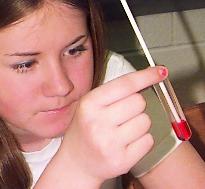 What are the disadvantages of an air thermometer?
Why don't we use them more often?
What are the disadvantages of an air thermometer?
Why don't we use them more often?
The air thermometer was one of the earliest kinds of thermometer. To measure a sick person's temperature, there was a version made of glass, with a bulb to put in the mouth. The air thermometer has several advantages: air is cheap and doesn't have any bad properties (unlike mercury, which used to be common in thermometers but really is too poisonous), and air expands more than any liquid or solid.
We can make our own thermometer, from these materials:
What is the sensitive part of the thermometer? To find out, try to heat only the water (by just immersing the very bottom). Also compare the behavior of your thermometer to another, which has a lot more water and a lot less air in it.
Interpret your results. What role do the different parts of the system (tube, cap, straw, water, coloring) play?
Here are some questions to discuss:
 What are the disadvantages of an air thermometer?
Why don't we use them more often?
What are the disadvantages of an air thermometer?
Why don't we use them more often?
Check the box when you are done:
Science content: thermal expansion